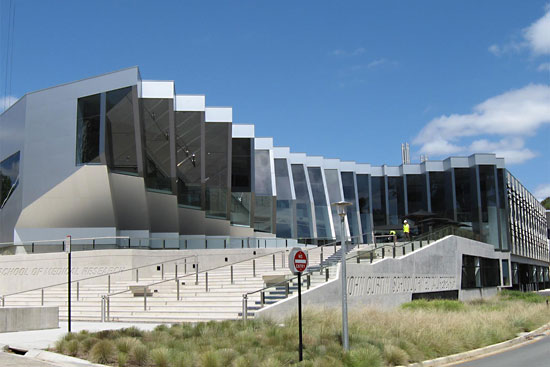ANU: Reflecting on Nobel prize winners from ANU
When Professor Brian Schmidt discovered the Universe was expanding at an accelerating rate, he thought he’d made a mistake.
His High-Z Supernova Search Team had expected their research to confirm the opposite, but instead their breakthrough changed our understanding of the cosmos.
In 2011 Professor Schmidt won the Nobel Prize in Physics “for the discovery of the accelerating expansion of the Universe through observations of distant supernovae”, sharing the award with fellow High-Z team member Professor Adam G Riess, and Professor Saul Perlmutter. Ten years ago this week, he received his prize in Stockholm, Sweden.
“When we got our results in 1998 we found the Universe wasn’t slowing down at all, in fact it was speeding up,” Professor Schmidt remarked in 2011.
“When we first saw the results, I have to admit that I thought we had made a mistake. It just didn’t make sense. It seemed too crazy to have 75 per cent of the Universe be missing and be a certain type of matter that pushes on itself.
“I was very reluctant to tell everyone but I knew we had to. That’s the way science works. You don’t want to prejudge the Universe; the Universe does what it does, our job is to measure it.”
Professor Schmidt is the most recent Nobel Prize winner at The Australian National University (ANU), which has hosted six Nobel Laureates whose research has increased our understanding of our world, and improved it for the better.
The first, perhaps fittingly, was former Chancellor Lord Howard Florey, who received the Nobel Prize for Physiology or Medicine in 1945, and also played a vital role in the establishment of ANU.
He shared the prize with colleague Ernst B Chain, and Alexander Fleming, who had discovered penicillin in 1928.
Lord Florey led the first clinical trials of penicillin in 1941, and with assistance from the United States government, the drug was used to treat wounded soldiers in the Second World War.
In a 1967 interview, Lord Florey said receiving the Nobel Prize was very gratifying, “but one should always realise that there’s a terrible lot of luck in this sort of thing”.
“We happened to have hit an antibiotic which worked in man. We could have worked with hundreds of others and they would have been chemical curiosities, so this was a bit of luck.”
Just after the war, Lord Florey was asked to write a memorandum on research in Australia for then-Prime Minister John Curtain.
“The opportunities for people to do research in Australian universities in medical subjects were at that time not very good and I virtually proposed the setting up of an institute in which medical research could be encouraged,” Lord Florey said.
“Eventually the proposal was to set up a university in Canberra…and I was asked would I assist in planning this.”
His vision inspired the ANU John Curtin School of Medical Research (JCSMR), which Lord Florey opened in 1958. He was later University Chancellor from 1965-68.
Since its founding, JCSMR has hosted three other Nobel Laureates.
Sir John Eccles, who spent a decade at JCSMR, shares the 1963 Nobel Prize in Physiology or Medicine with Alan L Hodgkin and Andrew F Huxley “for their discoveries concerning the ionic mechanisms involved in excitation and inhibition in the peripheral and central portions of the nerve cell membrane”.
Their research concerned the basic processes that cause electrical impulses, which control nerves and muscular movement.
The results deal with the nature of the nerve impulse itself and with the electrical changes that it causes in the bodies of nerve cells.
In 1996, Professor Peter Doherty and Professor Rolf M Zinkernagel jointly received the Nobel Prize in Physiology or Medicine for their discovery of how the immune system recognises virus-infected cells.
They carried out the research for which they were awarded the prize at JCSMR in 1973 to 1975.
While studying the response of mice to viruses, they found that white blood cells (lymphocytes) must recognise both the virus and certain self molecules – the so-called major histocompatibility antigens – to kill the virus-infected cells. This principle of simultaneous recognition of both self and foreign molecules has laid a foundation for the further understanding of the specificity of the cellular immune system.
The University’s sixth Nobel Laureate was forced to take a short and unintended sabbatical from his research.
When Professor John Harsanyi moved to Australia in 1950 his Hungarian university degrees were not recognised. During his first three years he worked in factories, while taking economics courses at night in Sydney. In 1958 he accepted a research position at ANU, before moving to the United States to pursue his interest in game theory.
In 1994 he received the Nobel Prize in Economic Sciences with John F Nash Jr and Reinhard Selten, for pioneering analysis of equilibria in the theory of non-cooperative games.
Professor Harsanyi showed how games of incomplete information can be analysed, thereby providing a theoretical foundation for a lively field of research – the economics of information – which focuses on strategic situations where different agents do not know each others’ objectives.
“Harsanyi’s approach to games with incomplete information may be viewed as the foundation for nearly all economic analysis involving information, regardless of whether it is asymmetric, completely private or public,” the Royal Swedish Academy of Sciences wrote in announcing his prize.

